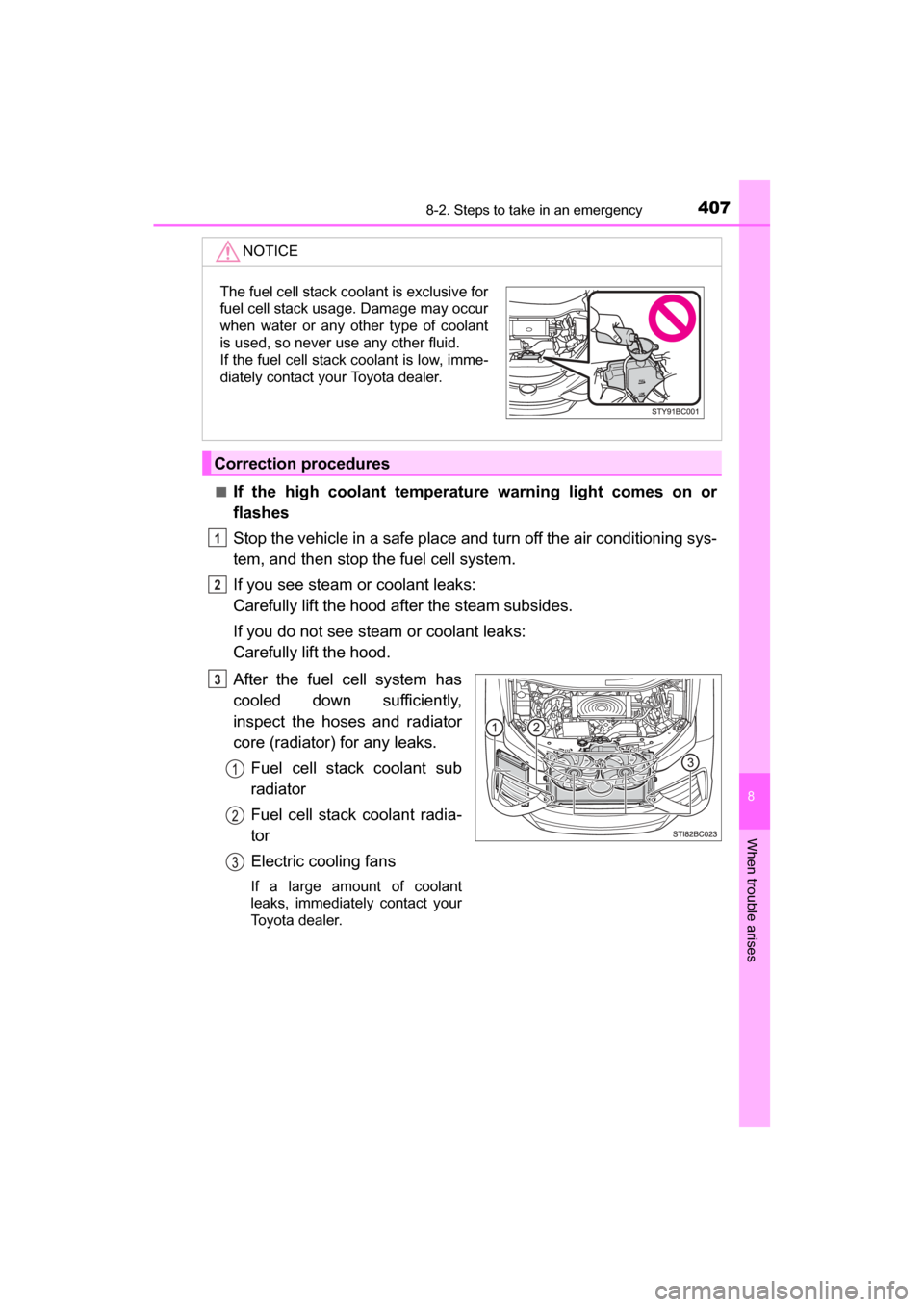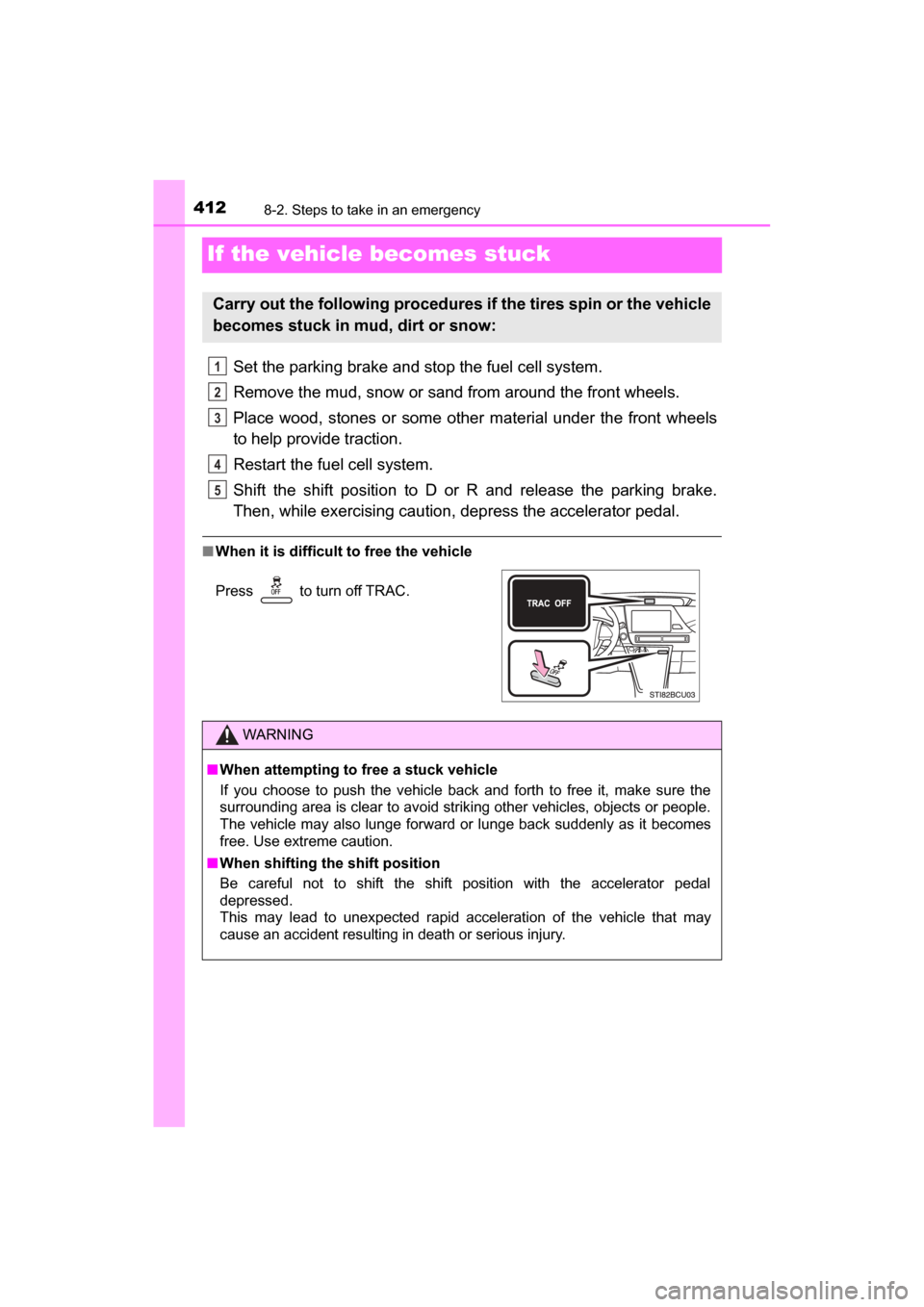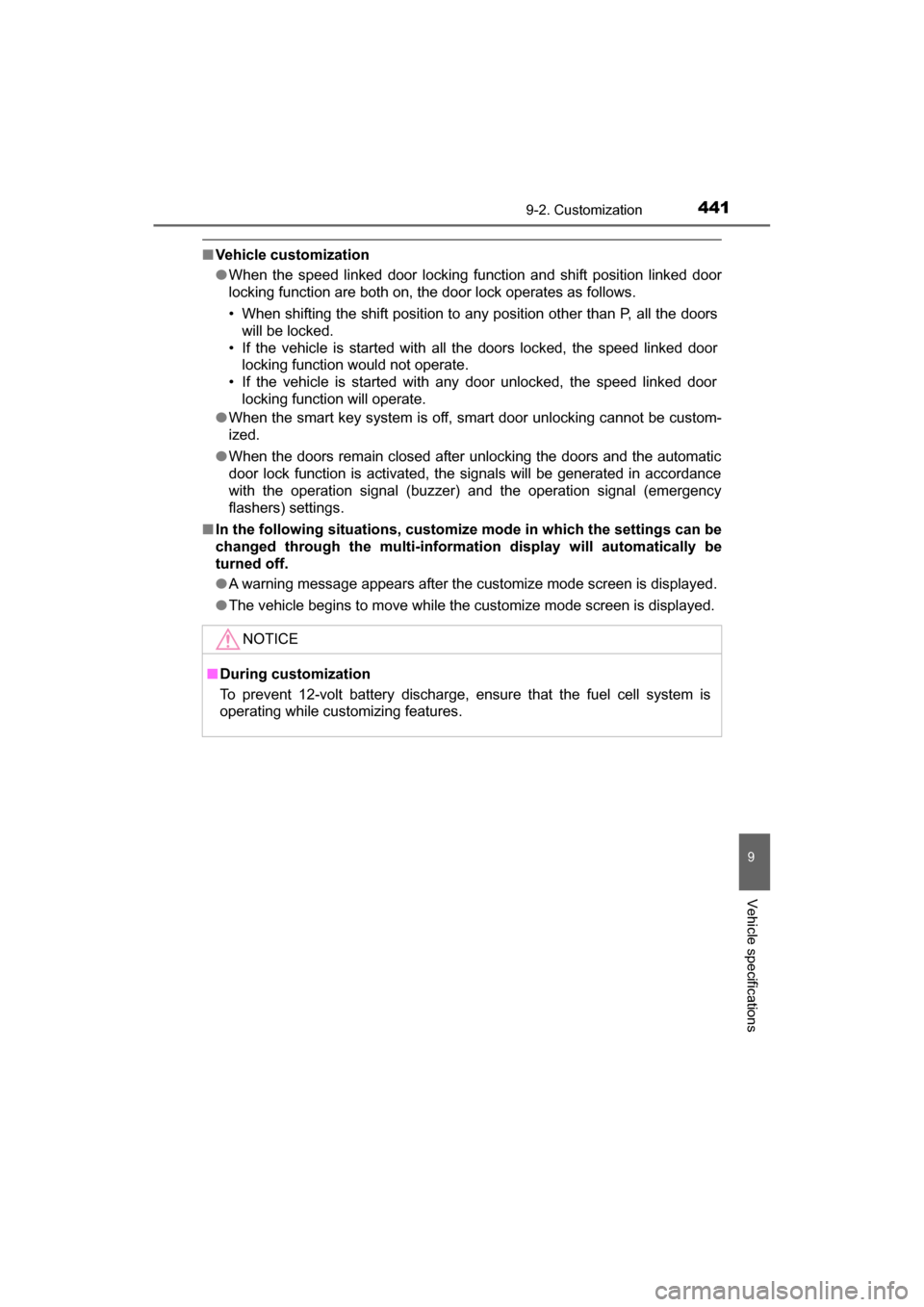2017 TOYOTA MIRAI warning
[x] Cancel search: warningPage 407 of 464

4078-2. Steps to take in an emergency
MIRAI_OM_USA_OM62023U
8
When trouble arises
■If the high coolant temperature warning light comes on or
flashes
Stop the vehicle in a safe place and turn off the air conditioning sys-
tem, and then stop the fuel cell system.
If you see steam or coolant leaks:
Carefully lift the hood after the steam subsides.
If you do not see steam or coolant leaks:
Carefully lift the hood.
After the fuel cell system has
cooled down sufficiently,
inspect the hoses and radiator
core (radiator) for any leaks.
Fuel cell stack coolant sub
radiator
Fuel cell stack coolant radia-
tor
Electric cooling fans
If a large amount of coolant
leaks, immediately contact your
Toyota dealer.
NOTICE
Correction procedures
The fuel cell stack coolant is exclusive for
fuel cell stack usage. Damage may occur
when water or any other type of coolant
is used, so never use any other fluid.
If the fuel cell stack coolant is low, imme-
diately contact your Toyota dealer.
1
2
3
Page 410 of 464

4108-2. Steps to take in an emergency
MIRAI_OM_USA_OM62023U
Start the fuel cell system and turn the air conditioning system on
to check that the radiator cooling fans operate and to check for
coolant leaks from th e radiator or hoses.
The fans operate when the air conditioning system is turned on immedi-
ately after a cold start. Confirm that the fans are operating by checking
the fan sound and air flow. If it is difficult to check these, turn the air con-
ditioning system on and off repeatedly.
(The fans may not operate in freezing temperatures.)
If the fans are not operating:
Stop the fuel cell system immedi ately and contact your Toyota
dealer.
If the fans are operating:
Have the vehicle inspected at the nearest Toyota dealer.
WARNING
■ When inspecting under the hood of your vehicle
Observe the following precautions.
Failure to do so may result in serious injury such as burns.
● If steam is seen coming from under the hood, do not open the hood until
the steam has subsided. The motor compartment may be very hot.
● After the fuel cell system has been turned off, check that the “READY”
indicator is off.
When the fuel cell system is operating, the cooling fans may suddenly
operate even if the fuel cell system stops. Do not touch or approach rotat-
ing parts such as the fans, which may lead to fingers or clothing (espe-
cially a tie, a scarf or a muffler) getting caught, resulting in serious injury.
● Do not loosen the coolant reservoir caps or radiator cap, while the fuel cell
system and radiator are hot.
High temperature steam or coolant could spray out.
6
7
Page 412 of 464

4128-2. Steps to take in an emergency
MIRAI_OM_USA_OM62023U
If the vehicle becomes stuck
Set the parking brake and stop the fuel cell system.
Remove the mud, snow or sand from around the front wheels.
Place wood, stones or some other material under the front wheels
to help provide traction.
Restart the fuel cell system.
Shift the shift position to D or R and release the parking brake.
Then, while exercising caution, depress the accelerator pedal.
■ When it is difficult to free the vehicle
Carry out the following procedures if the tires spin or the vehicle
becomes stuck in mud, dirt or snow:
1
2
3
4
5
Press to turn off TRAC.
WARNING
■ When attempting to free a stuck vehicle
If you choose to push the vehicle back and forth to free it, make sure the
surrounding area is clear to avoid striking other vehicles, objects or people.
The vehicle may also lunge forward or lunge back suddenly as it becomes
free. Use extreme caution.
■ When shifting the shift position
Be careful not to shift the shift position with the accelerator pedal
depressed.
This may lead to unexpected rapid acceleration of the vehicle that may
cause an accident resulting in death or serious injury.
Page 426 of 464

4269-1. Specifications
MIRAI_OM_USA_OM62023U
This information has been prepared in accordance with regulations
issued by the National Highway Traffic Safety Administration of the
U.S. Department of Transportation.
It provides the purchasers and/or prospective purchasers of Toyota
vehicles with information on uniform tire quality grading.
Your Toyota dealer will help answe r any questions you may have as
you read this information.
■DOT quality grades
All passenger vehicle tires must c onform to Federal Safety Require-
ments in addition to these grades. Quality grades can be found
where applicable on the tire sidewall between tread shoulder and
maximum section width.
For example: Treadwear 200 Traction AA Temperature A
■Treadwear
The treadwear grade is a comparative rating based on the wear
rate of the tire when tested under controlled conditions on a speci-
fied government test course.
For example, a tire graded 150 wo uld wear one and a half (1 - 1/2)
times as well on the government course as a tire graded 100.
The relative performance of tire s depends upon the actual condi-
tions of their use. Performance may differ significantly from the norm
due to variations in driving habits, service practices and differences
in road characteristics and climate.
■Traction AA, A, B, C
The traction grades, from highest to lowest, are AA, A, B and C,
and they represent the tire’s ability to stop on wet pavement as
measured under controlled conditio ns on specified government test
surfaces of asphalt and concrete.
A tire marked C may have poor traction performance.
Warning: The traction grade assigned to this tire is based on braking
(straight ahead) traction tests and does not include cornering (turn-
ing) traction.
Uniform Tire Quality Grading
Page 427 of 464

4279-1. Specifications
MIRAI_OM_USA_OM62023U
9
Vehicle specifications
■Temperature A, B, C
The temperature grades are A (the highest), B, and C, representing
the tire’s resistance to the generation of heat and its ability to dissi-
pate heat when tested under co ntrolled conditions on a specified
indoor laboratory test wheel.
Sustained high temperature can c ause the material of the tire to
degenerate and reduce tire life, and excessive temperature can lead
to sudden tire failure.
Grade C corresponds to a level of performance which all passenger
car tires must meet under the Federal Motor Vehicle Safety Stan-
dard No. 109.
Grades B and A represent higher levels of performance on the labo-
ratory test wheel than the minimum required by law.
Warning: The temperature grades of a tire assume that it is properly
inflated and not overloaded.
Excessive speed, underinflation, or excessive loading, either sepa-
rately or in combination, can cause heat buildup and possible tire
failure.
Page 441 of 464

4419-2. Customization
MIRAI_OM_USA_OM62023U
9
Vehicle specifications
■Vehicle customization
●When the speed linked door locking function and shift position linked door
locking function are both on, the door lock operates as follows.
• When shifting the shift position to any position other than P, all the doors
will be locked.
• If the vehicle is started with all the doors locked, the speed linked door locking function would not operate.
• If the vehicle is started with any door unlocked, the speed linked door locking function will operate.
● When the smart key system is off, smart door unlocking cannot be custom-
ized.
● When the doors remain closed after unlocking the doors and the automatic
door lock function is activated, the signals will be generated in accordance
with the operation signal (buzzer) and the operation signal (emergency
flashers) settings.
■ In the following situations, customize mode in which the settings can be
changed through the mu lti-information display will automatically be
turned off.
● A warning message appears after the customize mode screen is displayed.
● The vehicle begins to move while the customize mode screen is displayed.
NOTICE
■During customization
To prevent 12-volt battery discharge, ensure that the fuel cell system is
operating while customizing features.
Page 448 of 464

448What to do if... (Troubleshooting)
MIRAI_OM_USA_OM62023U
●The seat belt reminder light is flashing
Are the driver and the front passenger wearing the seat belts? (→P. 371)
●The brake system warning light is on
Is the parking brake released? (→P. 186)
Depending on the situation, other types of warning buzzer may also sound.
( →P. 369, 376)
●Did anyone inside the vehicle open a door during setting the alarm?
The sensor detects it and the alarm sounds. ( →P. 74)
To stop the alarm, turn the power switch to ON mode or start the fuel cell sys-
tem.
●Is the electronic key left inside the vehicle?
Check the message on the multi-information display. ( →P. 376)
●When a warning light turns on or a warning message or indicator is dis-
played, refer to P. 369, 376.
●Stop the vehicle in a safe place and replace the flat tire with the spare
tire. ( →P. 381)
●Try the procedure for when the vehicle becomes stuck in mud, dirt, or
snow. ( →P. 412)
A warning buzzer sounds during driving
A warning buzzer sounds when leaving the vehicle
An alarm is activated and the horn sounds
A warning light turns on or a warning message or indicator
is displayed
When a problem has occurred
If you have a flat tire
The vehicle becomes stuck
Page 449 of 464

449Alphabetical index
MIRAI_OM_USA_OM62023U
Alphabetical index
A/C ............................................ 258Air conditioning filter ............. 351
Automatic air conditioning
system ......... ....................... 258
ABS
(Anti-lock Brake System)...... 232 Function ................................ 232
Warning light ......................... 370
Air conditioning filter .............. 351
Air conditioning system .................................... 258
Air conditioning filter ............. 351
Airbags ....................................... 36 Airbag operating conditions .... 44
Airbag precautions for
your child .............................. 39
Airbag warning light .............. 370
Correct driving posture ........... 28
Curtain shield airbag operating conditions ............. 45
Curtain shield airbag precautions ........................... 42
Front passenger occupant
classification syst em............. 49
General airbag precautions .... 39
Locations of airbags................ 36
Modification and disposal of airbags ............... 43
Seat cushion airbag ................ 36
Side airbag operating conditions ............................. 45
Side airbag precautions .......... 41
Side and curtain shield airbags operating conditions ............. 45
Side and curtain shield airbags precautions ........................... 42
SRS airbags............................ 36 Alarm .......................................... 74
Anchor brackets ........................ 69
Antennas
(smart key system) ............... 131
Anti-lock Brake System
(ABS) ...................................... 232 Function ................................ 232
Warning light......................... 370
Armrest..................................... 281
Assist grips .............................. 282
Audio input
*
Audio system*
Steering wheel audio switch*
Automatic air conditioning system.................................... 258 Air conditioning filter ............. 351
Automatic headlight leveling
system.................................... 189
Automatic High Beam ............. 190
Automatic light control system.................................... 187
AUX port
*
Auxiliary box ............................ 276
A
*: Refer to the “NAVIGATION SYSTEM OWNER’S MANUAL”.